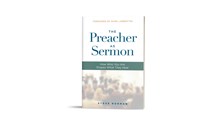
Chapter 132
How to Preach Like John Grisham Writes
I needed to move from principle to plot
During a recent vacation, my wife and I ventured across town to another church. The jammed parking lot and crowded lobby suggested a scintillating sermon. The preacher was articulate and entertaining. His sermon was biblical, with four crafted principles from the text.
But as we left that morning, I realized, as William Willimon has said, I got the sermon, but it didn't get me.
Fast-forward to a couple of days later, same vacation: Sitting under a thatched umbrella on a beach, I'm reading John Grisham's The Chamber, a novel about capital punishment.
Toward the end of the story, Grisham describes Sam Cayhall, the death-row inmate, taking off the clothes he has worn for so many years. His new clothes lying on the bed are for his execution in the gas chamber. The portrayal overwhelmed me, and I began to weep. As a tear rolled down my cheek, I silently asked the Lord to forgive me for my past hatred of death-row inmates.
It struck me that Grisham's novel had "got" me in a way the principled sermon I'd heard hadn't. I began studying what makes a good story work. As I applied the elements of plot to my sermon structure, they revolutionized the way I create and deliver a sermon.
Starting with surprise
A plot-based sermon is not one with more stories in it. It is not created by cramming more illustrations into a sermon or seeing the sermon as one lengthy illustration.
The very structure of a plot-based sermon is different. The difference between a plot-based sermon and a principle-based sermon is not hermeneutical but homiletical. A plot-based sermon still requires traditional exegesis; I still have to immerse myself in the text. But once I do my exegetical spadework, I head in a new direction. I steer away from principles and launch out into the realm of surprise, tension, and disequilibrium.
Obviously, this is easier with narrative literature, but every text is set in a context, in a story and a situation. And every situation has some disequilibrium or tension.
As I begin thinking about my sermon, I ponder what my audience might expect from this text. Then I do my best to avoid their expectations. As I start the sermon, I want people to wonder, "Where is he going with this?"
In The Homiletical Plot, Eugene Lowry illustrates with the old Quincy TV show (a more recent example is CSI). Both shows start with a dead body—no surprise there. The interest factor is the uncertainty—"Who did it?" "How did they do it?" "Why did they do it?" "How will Quincy or Jessica figure it out?"
In a recent sermon on the Parable of the Rich Fool in Luke 12, for example, the congregation expected I would oppose the Rich Fool. So I showed how much I identified with him. I viewed him as a financially fortunate farmer: "The Rich Fool seems wise to us. He earned his money honestly. He was hard-working. He invested and expanded. He used his surplus to plan for his retirement. Money magazine would profile him as a financial genius."
I used a quote: "If this man is a fool, then a lot of Americans are fools!" I told my audience I had recently calculated the money I'd have for retirement in twenty years if, instead of giving to the church and missionaries during the past four years, I had invested it. The tally was more than $200,000. I then asked them to decide whether having $200,000 less at retirement was wise or foolish.
To my suburban congregation, that created disequilibrium, tension, and surprise.
Building tension
In the exegetical phase of sermon preparation, I search carefully for any textually-based disequilibrium.
While preaching on the life of Paul, for example, I found some delicious disequilibrium in Acts 27. Luke tells about riding out a storm with Paul. The storm rages with no word from God. Luke writes in 27:20 that they finally "gave up all hope" of being saved.
I could have ruined the sermon at that point by chiding my audience, "But of course, we all know the doctrine of omnipresence, so we know God was there—the principle of his presence!" The temptation is to play down disequilibrium in the text, as if it's my job to make God look good. One commentator on this passage used the four anchors from Acts 27:29 as "four anchors to keep us from shipwreck during life's storms." But the problem here is not only homiletical but theological—Paul's ship does shipwreck!
My goal is to play up the tension. In all good stories, things unravel, creating more tension until the climax. My tendency has been to reach the last chapter too quickly. But the heart of the sermon, like the heart of a novel, is a thickening plot.
While preaching a series on the life of Abraham, I used him as an example of what it's like to be a friend of God. To build tension, I asked my audience whether they would treat a friend like God does.
Abraham and Sarah waited twenty-five years for God to give them the promised child. I told my audience I could understand what Abraham was feeling during those years. Although God didn't promise me a son, I know what it's like to wait to have a child. My wife, Jan, and I are still waiting. We have been married for twenty-four years. We planned to have children, raise a family, and joyfully serve the Lord. We are now a childless couple in midlife.
I told the audience that when I read the news account of a mother who drowned her two children in South Carolina, anger welled up in my heart. My passion was not as much toward her as toward God. Why allow her to have children, and not us? I'd never do what she did.
There is power in a sermon that asks some questions.
Wrapping it up
But the tension created by the disequilibrium eventually has to be released. The time clock runs out in the fourth quarter of the game. The Book of Revelation resolves the tension between God and Satan. In good stories and sermons, the denouement (or resolution) is brief. Using the TV-drama analogy, a sermon's denouement should not take more than five minutes.
This part of the sermon feels most like traditional preaching to me. It is the time for propositional statements about God. It is the time to explain the "rest of the story." But it must not drag on and on.
In my sermon on the Parable of the Rich Fool, the denouement was simple—"If you're not careful, your money can make a fool out of you. Storing wealth is foolish, but sharing wealth is wise." I mentioned the $200,000 less I'll have for retirement and reminded the audience that even though someone may say, "What a fool," God says, "How wise!"
This was a stewardship sermon in preparation for a campaign banquet. I suggested to the audience that as they filled out a pledge card the next week, someone might look at their card and judge them a fool. I hoped it wasn't God.
Finally, I told about two little girls named Kaylee and Whitnee, who had sold caramel apples and cookies the week before. A little sign at their booth read: "Everything we make is for our new church building." I held up the envelope they gave me earlier that morning. Scrawled in a little girl's handwriting was the figure $36.75 and then: "For the new church. Love, Whitnee and Kaylee." I concluded by asking my audience whether God's response was "What fools," or "What wise little girls"?
Producing sermon principles is easy; creating sermonic plot is arduous. To help me produce better plot-based sermons, I read fiction, take in movies and dramas, listen carefully to the stories of those who see me for pastoral care, and pay attention to the lyrics of country music—"Sometimes you're the windshield, sometimes you're the bug."
But fueling my creativity more than anything, perhaps, is the disequilibrium of my own story.










